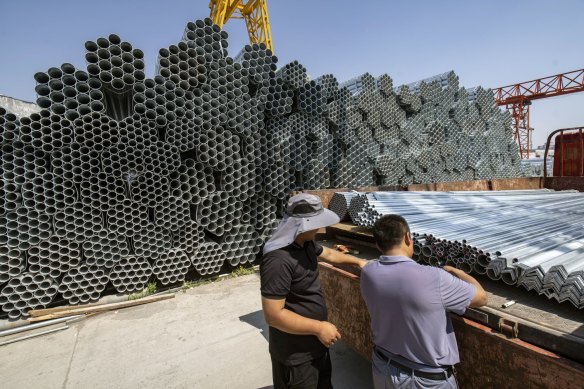Falling iron ore prices could punch a $3 billion hole in the budget over the next four years, according to analysis by the federal Treasury.
A drop in tax receipts from iron ore sales had been forecast in last May’s budget, but prices for the commodity have fallen further, more quickly than expected.

The funk in China’s steel market has global implications as iron ore prices languish.Credit: Bloomberg
The decline in the price is linked to China posting weaker growth figures than expected in the June quarter, with a downturn in the country’s property sector reducing demand for steel used for construction amid a softening of consumer confidence and investment.
While Treasury has forecasted the iron ore price to fall to the long-run anchor price of US$60 per tonne by March 2025, last week the price fell to US$81.80 per tonne, below Treasury’s $US83 forecast.
The world’s largest steelmaker, China’s Baowu Steel Group, has issued a warning that the downturn in the country’s steel industry could be deeper than industry downturns in 2008 and 2015.
If the current trend continues, the long-run price could return to $US60 per tonne about six months earlier than forecast – causing the $US3 billion revenue downgrade.
Treasurer Jim Chalmers said on Sunday that the softness in the Chinese economy and the falls in iron ore prices were a reminder that Australia was not immune from volatility and uncertainty in the global economy.
“This is exactly why we take such a cautious and conservative approach to Treasury’s forecasts for resource prices and revenue,” he said. “We’re following these developments very closely because of their potential impact on our economy and our budget.
“We’ve delivered the first back-to-back surpluses in almost two decades at the same time as we’re easing cost of living for Australians. We’ve always put a premium on responsible economic management, and that’s especially important amidst all this global uncertainty.”
Reserve Bank governor Michele Bullock, who suggested last week that home buyers and businesses in Australia could wait until after Christmas for a cut to interest rates, highlighted the risks of a contracting Chinese economy to Australia.
“The Chinese economy is still performing OK. It’s meeting their target of around 5 per cent growth, but they still have a very big drag from the problems in their real estate sector there,” Bullock said.
“That is something that we’re watching quite closely because … developments in China can have quite a big impact on the way our trade develops and therefore on our growth.”
The federal government unveiled a surplus of $9.3 billion in May, following a $22.1 billion surplus in 2022-23, but a deficit of $28.3 billion is forecast for 2024–25.
Finance Minister Katy Gallagher said on Sunday the fall in iron prices had been expected and that revenue forecasts would be updated in the mid-year budget update in December.
“Obviously, any decline in the iron ore price impacts revenue to the budget,” she said. “We don’t have decreasing pressures on the budget. We’ve got increasing pressures on the budget, so any change like that certainly has an impact, but we do put conservative figures in the budget for that reason.”
Cut through the noise of federal politics with news, views and expert analysis. Subscribers can sign up to our weekly Inside Politics newsletter.